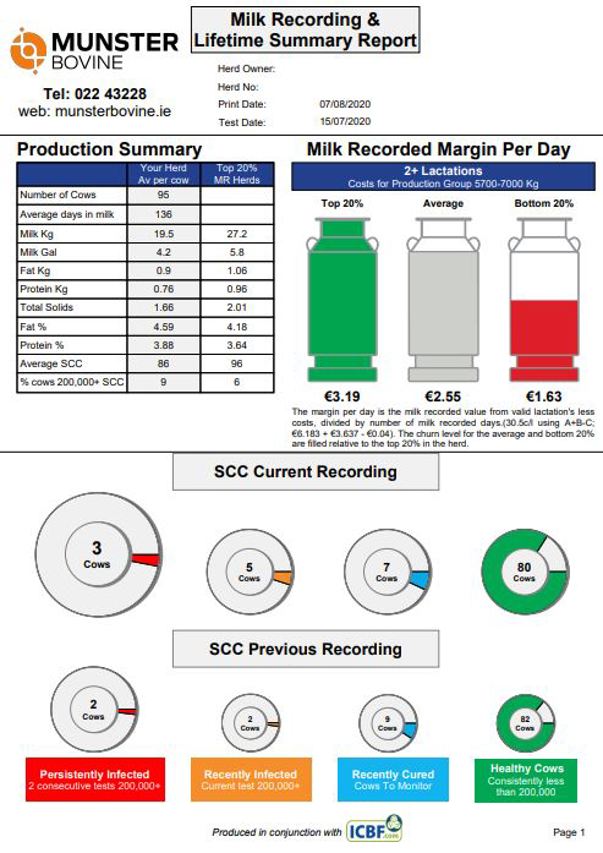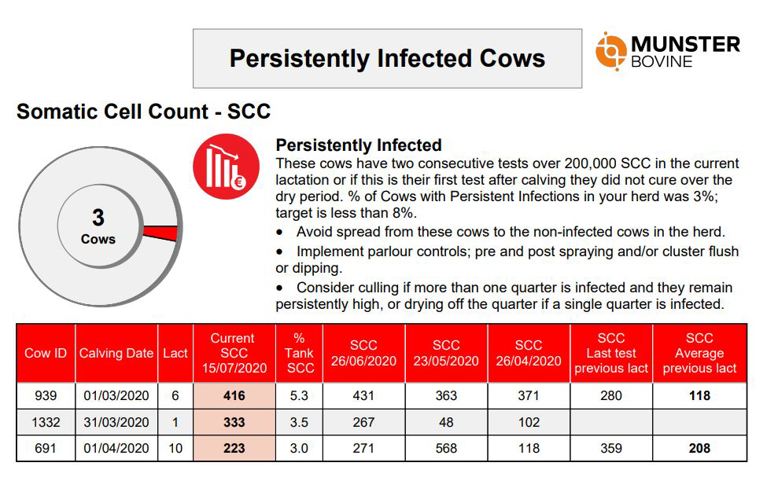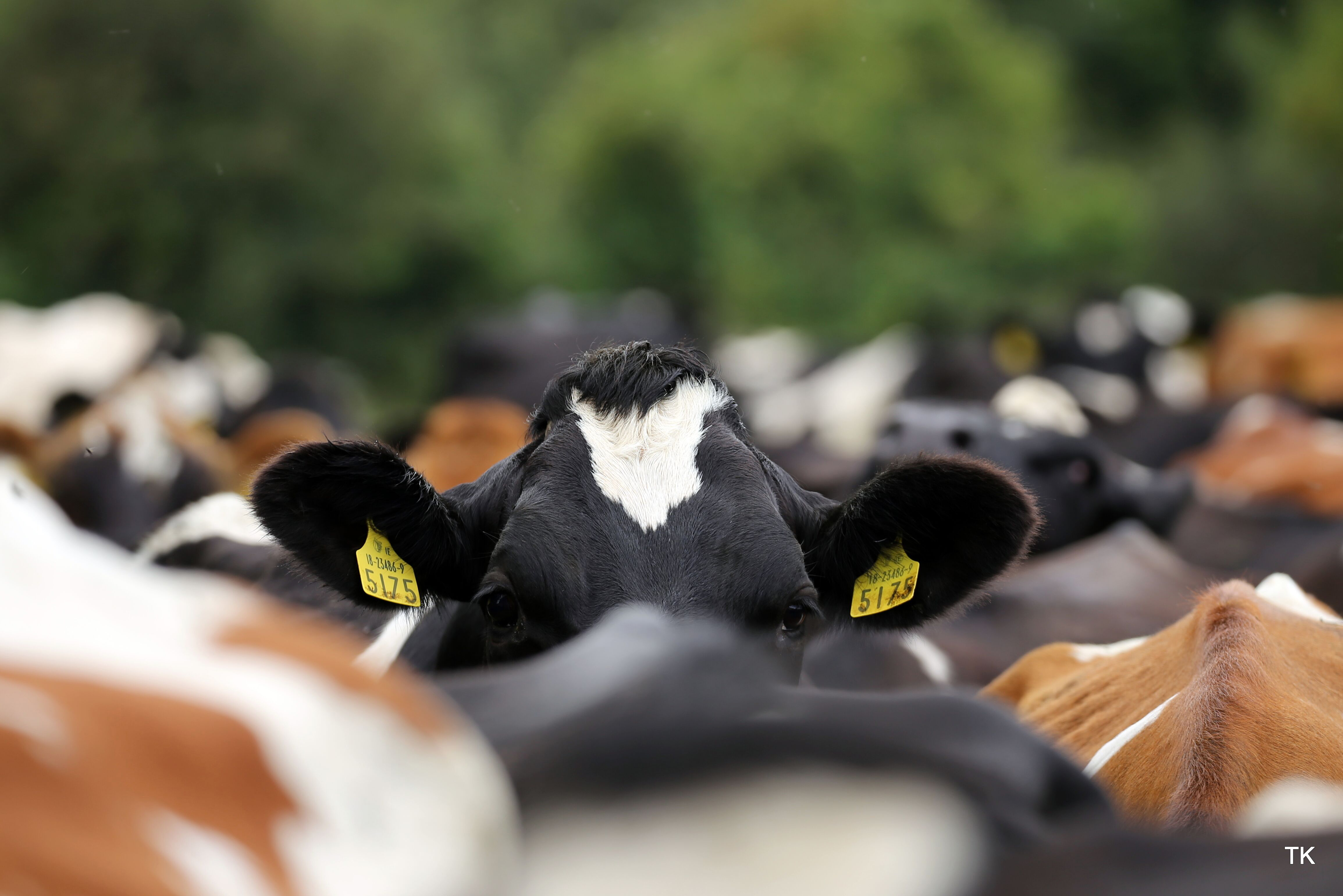News
INTRODUCTION
Milk recording allows farmers to obtain detailed information about the milk production performance of individual cows. By tracking factors such as milk yield, milk composition (fat, protein), and somatic cell count, farmers can identify cows with superior genetic traits for milk production. This information is valuable for making informed decisions regarding breeding, selection, and culling, leading to the improvement of the overall herd's productivity.
USING YOUR MILK RECORDING AND LIFETIME SUMMARY REPORT TO MAKE BEST DECISIONS FOR YOUR HERD IN 2023
Breeding Decisions
- Breeding from your better performing higher genetic merit cows will drive genetic gain and improve future performance.
- Avoid breeding replacements from cows in red (bottom 20%) for either lifetime, year to date or both (double reds). Use high beef subindex dairy beef sires, with suitable calving difficulty on these cows.
- Use an appropriate number of dairy straws (conventional, sexed or both), to breed your future replacements from the better performing non red cows.
Controlling SCC
- Achieving a low SCC will result in better performance (more milk in the tank) and lower antibiotic usage.
- Each milk recording allows you to monitor each cow for SCC individually, building an SCC history and enabling you to make decisions on milking routine, treatment, culling etc.
- The milk recording lifetime report categorises each cow depending on the infection status (persistently infected, cured, and healthy), allowing easy identification of cows that need attention.
Retention Decisions
- Achieving good fertility performance combined with good health (low incidence of lameness,
mastitis, SCC etc), creating the opportunity for you to sell your poorest performing cows. - If selling the poor performance, target cows in red on lifetime margin per day and red on year to
date ‘double reds’. - Improved performance of the bottom 20% will see the red churn at the top of your report become
fuller, indicating better overall performance and a more uniform production herd.
Figure 6 below shows the Milk Recording and Lifetime Summary Report.

Figure 7 below shows the Persistently infected cows report. Direct action on cows showing in this report needs to be taken.

SELECTIVE DRY COW THERAPY (SDCT)
“USE AS LITTLE AS POSSIBLE AND AS MUCH AS NECESSARY”
- New legislation in place since January 2022 supports the prudent use of antibiotics which translates to “Use as little as possible and as much as necessary”.
- Therefore, a blanket approach to dry cow therapy where every cow regardless of her cell count status receives an antibiotic at dry off, is not permitted. However, your vet must make a judgement call within the parameters of the legislation regarding your herd and prescribe accordingly by considering each cow individually and the potential risk of mastitis during the dry period and into the next lactation.
- The threshold for a ‘low cell count’ cow will vary with vet advice and farm conditions. Currently, cows with cell counts consistently under 100,000 cells per ml for all recordings and no case of mastitis are considered low risk cows.
- Your veterinary practitioner needs individual cow information to assess the risk of infection to the individual cows in your herd.
SOURCES OF INDIVIDUAL COW INFORMATION
- Recording: Milk recording cows using milk meters or EDIY equipment provides a representative milk sample from all four quarters and is repeatable and reliable.
- If milk recordings are not available: Most Coops offer a service to test samples from individual cows collected by the herdowner.
- If it is not practical or possible to either get a single recording done or have each cow’s milk tested for SCC pre-dry off: Vets may seek individual cultures for cows or CMT testing to be carried out on each cow.
- Vets will use their clinical judgement and knowledge of the farm system to inform prudent prescribing and recommend best practice for the monitoring of cell count and mastitis cases.
RECORDING MASTITIS CASES
- Some cows may have a low cell count on the recordings but may have had a case of mastitis during the year and should be selected for dry cow treatment. All cases should be recorded on farm software or directly to ICBF by text. This info will feed into the Cellcheck veterinary reports.
- Knowing the type of bacteria and their resistance pattern to antibiotics helps in prescribing the correct tube and deciding whether some cows with persistent SCC are worth treating or not.
- 50% of Staph. aureus bacteria isolated from cows in Ireland are resistant to penicillin. In cows over three lactations, with persistent high cells counts and infected with Staph. aureus, the success rate of treatment with any treatment may be less than 30%. Culling is a better option.
- Clinical mastitis cases should be sampled for the type of bacteria present in the quarter. A sample should be taken BEFORE treating a case. Samples can be kept in the fridge for 24 hours or because mastitis bacteria survive freezing, you can store samples in the freezer for up to four months.
- Cows with high cell counts often have no clinical signs of mastitis – no clots, no discoloured milk. Remember a high cell count is also a mastitis event – you just can’t see it. Use the CMT to detect which quarter is infected and then sample from this quarter.
KEY SUCCESS FACTORS FOR SDCT
- Speak to your vet and make sure the SCC threshold is right for your herd.
- Select the right cows using cell count records and mastitis case history.
- Use the right antibiotic on the right cows by sampling mastitis cases.
- Have a cubicle per cow for the dry period.
- Dy off correctly.
- Excellent hygiene, tails clipped, clean cows.
- Take your time, 10-20 cows per person per session.
- Use a headlamp.
- Dry-off cows abruptly once production reaches 9 litres per day – do not skip days and do not skip milkings.
- If using teat sealer only on a portion of the herd, dry these off in a separate batch from cows getting antibiotic or antibiotics and teat sealer.
- Have a system for cleaning the teats - Disinfect the teats furthest away first followed by the teats nearest to you. Treat the teats nearest you first followed by the more distant teats to prevent recontamination the teats.
- Ensure cows remain standing for the first 2 hours after sealing to allow time for the teat canal to close.
- Ideally, cows that have been dried off should be kept away from the sound of the milking machine to avoid milk let down.
- Put cows in clean areas after treatment and clean and lime cubicles twice a day.
- Do not use antibiotics on cows that are going to be culled within the next 2-3 months.
- Don’t use antibiotic tubes on quarters that were dried off during the previous lactation.
- Check each cow that received antibiotics has passed her minimum dry period when she calves and withhold milk from the bulk tank for the period specified by the product.
- Withhold milk from all cows from the bulk tank for at least 8 milkings after calving to ensure that no colostrum or transition milk goes into the tank. This also prevents teat seal residues from entering the bulk tank
Related Articles
Achieving Your Breeding and Fertility Goals - Milk Matters April 2024

Herd Health Meetings with Munster Bovine Vets this Autumn – Common Threads and Lessons Learned During 2023.

Herd Health Decisions and Tasks for the Dry Period

Munster Bovine Launches New Website
